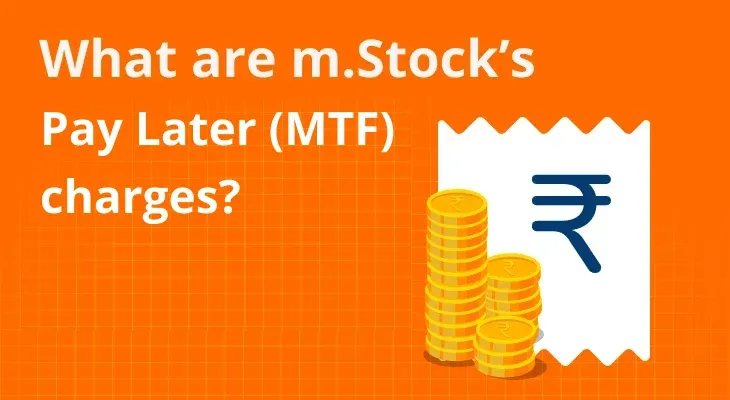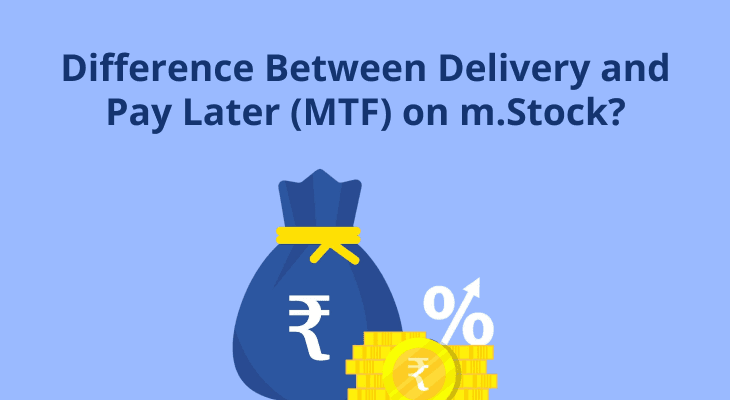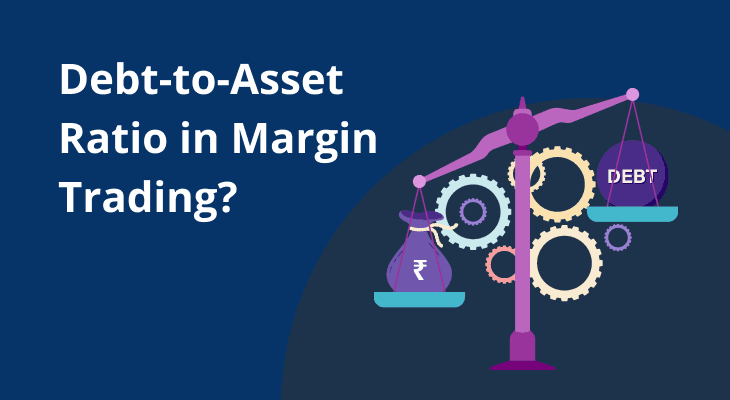
What are m.Stock's MTF charges?
Introduction to Margin Trading Facility (MTF)
There are times when certain stocks are in an uptrend due to some favorable news about a sector or company. In such cases, investors may want to buy large quantities of such stocks. However, lack of funds (capital) may restrict or limit them from being able to take the position. In such situations, investors can use margin trading facility (MTF) instead of missing out on the opportunity.
MTF is a facility which allows investors to buy stocks by paying a fraction of the total transaction value upfront (just like you pay a down payment for your loans). Your broker (m.Stock) funds the balance trade value (up to 80%) in exchange for interest.
The interest charged on your MTF trade is very important as it directly affects your take home profit. This is where m.Stock’s Pay Later (MTF) stands out. m.Stock offers one of the lowest MTF interest rates in the industry. Yes, while MTF interest rate in the industry can go as high as 24% p.a., Pay Later interest rate with m.Stock starts as low as 6.99% p.a. for funding above ₹5 crore. Even the maximum MTF interest is capped at 9.99% p.a. (on funding of up to ₹5 crore).
Interest is one of the many MTF charges that investors have to bear. In this article we will discuss about various MTF charges and also learn about m.Stock’s Pay Later charges.
m.Stock MTF charges #1: Interest charged on funding amount
Interest charged on MTF trades and your take home profits have an inverse relationship. So, the higher the interest charged, the lower your take home profits will be. As per industry standards, MTF interest can go as high as 18% p.a. to 24% p.a. However, with m.Stock, MTF interest rate ranges from 6.99% p.a. to 9.99% p.a.
The interest charged by m.Stock on MTF depends on two factors: gross funding value and holding period. The below table shows our Pay Later funding slabs and interest charged.
| Funding Value | Interest Charged (p.a.) |
|---|---|
| Above ₹5 crore | 6.99% |
| Above ₹25 lakh to ₹5 crore | 9.99% |
| Up to ₹25 lakh | 14.99% |
Let us understand how MTF interest is charged with an example. Say you want to place a trade worth ₹35 lakhs (total trade value). With m.Stock, you will get up to 80% funding i.e. ₹28 lakhs. As per the above slab, you will have to pay interest @9.99% p.a. Assuming you hold this position for a year, the total interest payable on this trade will be ₹2.51 lakhs (for one year). The interest levied on MTF is payable on a daily basis and is debited from your ledger directly till the time you hold the position.
In comparison, if you availed the same funding (₹ 28 lakhs) with other broker charging 12% p.a., your total interest payable will be ₹ 3.36 lakhs i.e., ₹ 85,000 extra. Hence, from an interest rate point of view, m.Stock’s Pay Later (MTF) makes better financial sense.
You can use our MTF calculator to calculate interest savings on your Pay Later (MTF) trades.
m.Stock MTF charges #2: Pledge and unpledge charges
Margin trading facility involves pledging stocks in favour of the broker.At m.Stock, pledge creation & closure charges will be ₹32 per PSN (Pledge Sequence Number) per day (+GST) for Pay Later (MTF) orders.
At m.Stock, pledge creation & closure charges will be ₹32 per PSN (Pledge Sequence Number) per day (+GST) for Pay Later (MTF) orders.
m.Stock MTF charges #3: Subscription charges
Most brokers charge a subscription fee to avail their margin trading facility which can be as high as ₹10,000 a year. But with m.Stock, there is no subscription fees as Pay Later facility comes free with your m.Stock Demat account.
While you may think ₹10,000 annual or even one-time subscription fee isn’t much, it does increase your effective rate of interest. Let us see how. Continuing with the above example, the interest rate charged by your broker on borrowing of ₹28 lakhs is 12% p.a. But when you add subscription fee of ₹10,000 in the equation, your effective interest rate increases from 12% p.a. to 12.36% p.a. Zero subscription fees is another key reason to opt for m.Stock’s Pay Later facility.
With such high savings at stake, opting for m.Stock’s Pay Later (MTF) makes financial sense. You get up to 80% funding and can seize lucrative investment opportunities in 1,070+ mtf stocks, whilst paying low interest rates. To avail m.Stock’s Pay Later facility, simply open an m.Stock demat account and trade big without paying big!
Read Also: What is the Rate of Interest Charged on Margin Trading Facility?
FAQ
What is the deadline to complete the MTF pledge process?
m.Stock is the first broker that allows pre-pledging of stocks. However, in case of partial execution of margin trades or partial selling under MTF or CNC (Cash and Carry), you need to complete the pledge process post-trade. The deadline to pledge is 10:00 a.m. on the Settlement Day, i.e., T+1 day. The whole process needs to be done via a CDSL link sent to you over an SMS/email.
What is the margin required?
Margin required is similar to the down payment you pay when you opt for any kind of loan. In case of MTF, margin required is the minimum amount you must maintain in your trading account to take a position. With m.Stock, you only need to maintain 20% margin since you get up to 80% funding on the total trade value. You should always maintain the required margin to avoid your position being squared off automatically.
What is the interest rate charged on MTF by m.Stock?
The interest rate levied on m.Stock's eMargin facility depends on the funding value. m.Stock charges 9.99% p.a. interest on a funding value up to ₹5 Crore. If the funding value crosses ₹5 crore, interest drops to 6.99% p.a., which is one of the lowest in the industry.
How long can I hold the stocks purchased via m.Stock’s MTF?
With m.Stock's MTF (eMargin) you can keep your position open as long as you want. There is no limit on the holding period. However, you will have to maintain the required margin throughout the trading tenure.
When will I start incurring interest charges?
The interest charges on MTF are levied on a daily basis and will become applicable from the day you avail eMargin facility.
What are the charges for pledging/un-pledging shares under MTF?
m.Stock charges pledge fee of ₹25 per pledge request under the lifetime free AMC plan and ₹32 per pledge request under the quarterly AMC plan.
For which segment can I use the MTF?
Currently, you can use MTF for the equity segment (cash market) only.
Is MTF available for intraday trading?
No, MTF is not applicable for intraday trading. It is available for delivery trades only. However, you are allowed to sell your shares on the same day.
What will happen to shares purchased under MTF if I don't maintain the required margin?
If you don't maintain the required margin in your trading account, the shares you purchase will be automatically squared off. The broker will settle the balance amount after deducting the applicable interest charges.


